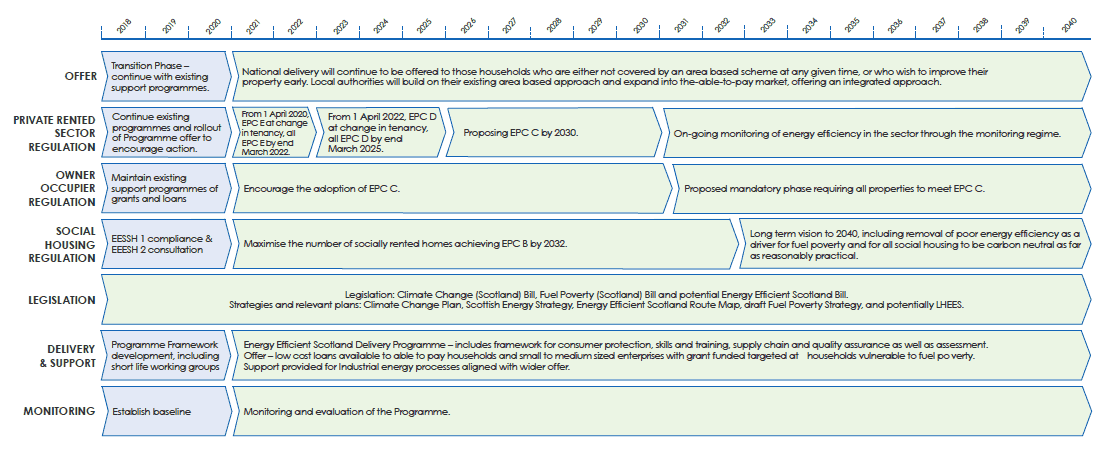Energy Efficient Scotland: strategic environmental assessment
This Strategic Environmental Assessment (SEA) investigates the likely significant effects on the environment by the implementation of the Energy Efficient Scotland programme.
10 Next Steps
10.1 Notes for Respondents
10.1.1 Public views and comments are invited on the environmental impacts of the proposed setting of a long terms standard, energy efficiency standards for social housing, Local Heat & Energy Efficiency strategies ( LHEES) and the regulation of district and communal heating as set out in this Environmental Report. Should a respondent wish to make a joint response on the Environmental Report for some, or all, of these proposals, we ask that respondents clearly indicate to which proposal the comments relate to.
Providing comments on this Environmental Report
Respondents are asked to submit responses on the Environmental Report by 27 th July 2018 to
Energy Efficient Scotland ConsultationEnergy Efficient Scotland Programme Management Office
Scottish Government
1H South
Victoria Quay
Edinburgh EH6 6QQ
Email: EnergyEfficientScotland@gov.scot.
10.1.2 Respondents may find the following questions helpful to provide a focus for their responses on this Environmental Report. Please note that responses do not need to be confined to these questions, and more general comments on this Environmental Report, and the proposals are also invited.
What are your views on the accuracy and scope of the information used to describe the SEA environmental baseline set out in the Environmental Report? (Please give details of additional relevant sources)
What are your views on the predicted environmental effects as set out in the Environmental Report?
What are your views on the findings of the SEA, and the proposals for mitigation and monitoring of the environmental effects set out in the Environmental Report?
10.1.3 The responses received on this Environmental Report will be collated, analysed and reported. Key messages and findings of the responses received will be taken into account in the finalisation of each of the proposals.
10.1.4 Post-adoption SEA Statements will be prepared and published for each proposal. These statements will reflect on the findings of the assessment and consultation, and will explain how the issues raised have been considered and addressed in the preparation of the finalised proposals.
10.2 Next steps for the Programme
10.2.1 Details of the timeline for the development of future projects under the banner of the Programme is set out in the Routemap. Aspects of these projects will require SEA and screening will therefore be undertaken at the earliest opportunity to assess the requirements.
10.2.2 A summary for each sector is as follows:
Non-Domestic
| Transition | General | Advice | Delivery | Finance | Service | ||
|---|---|---|---|---|---|---|---|
| Offer | In the Transition Phase we will expand current local delivery programmes into able-to-pay households and businesses, drawing on national advice and financial support. | The foundation of the Programme offer is that all businesses will be able to access good quality, independent advice and information on improving the energy efficiency of their building(s) and reducing their fuel bills. | National Delivery - continue to be offered to those businesses who are either not covered by an area based scheme at any given time, or who wish to improve their property earlier than backstop date. | Local authorities expand their current approach to delivery by developing a Local Heat and Energy Efficiency Strategy ( LHEES) setting out a costed delivery plan for its area. | Subsidise cost of interest free loans for SME sector. As non-domestic baseline developed there is potential to consider a more targeted approach to certain businesses (in terms of size or sector). Large businesses and public sector have ready access to finance resources. | ||
| Regulation | The scenario proposes the use of building floor area to bring a roughly equal proportion of buildings under regulation within a five yearly review of regulations. | The Assessment of Energy Performance of Non-domestic Buildings (Scotland) Regulations 2016 introduced a requirement for owners of larger non-domestic buildings (>1,000 m²) to assess and improve the emissions and energy performance of their buildings. The requirement is triggered by sale or rental. | The output of an assessment is an ‘Action Plan’ that records both the improvement targets and the measures that will be undertaken to meet them, based upon advice from a registered Advisor. | Energy and emissions improvement targets will be set at a level that will pay back investment over an appropriate timescale. This will reinforce the message that ‘simple improvements make sound business sense’. |
Non Domestic Programme Overview

Domestic
| Transition |
General |
Advice |
Delivery |
Finance |
Service |
||
|---|---|---|---|---|---|---|---|
| Offer |
In the Transition Phase we will expand current local delivery programmes into able-to-pay households and businesses, drawing on national advice and financial support. The two year programme will incrementally offer local authorities greater opportunities to plan and deliver integrated energy efficiency projects. |
The Programme offer will consist of a universal end-to-end offer made by either a local authority or the Scottish Government. |
The foundation of the Programme offer is that all households will be able to access good quality, independent advice and information on improving the energy efficiency of their property and reducing their fuel bills. |
Tackling fuel poverty – Area based schemes and Warmer Homes Scotland. National delivery |
Local delivery - Local authorities expand their current approach to delivery by developing a Local Heat and Energy Efficiency Strategy ( LHEES) setting out a costed delivery plan for its area. |
A mixture of grant and loan funding across different tenure and sectors to tackle fuel poverty and enable achievement of standards. |
The Programme customers should be offered a consistent, quality level of service at each stage of the process. Independent advice will be the bedrock, advising property owners on the standards they will be expected to achieve, deadlines, trigger points, programmes and funding. |
Domestic Programme Summary

Contact
There is a problem
Thanks for your feedback